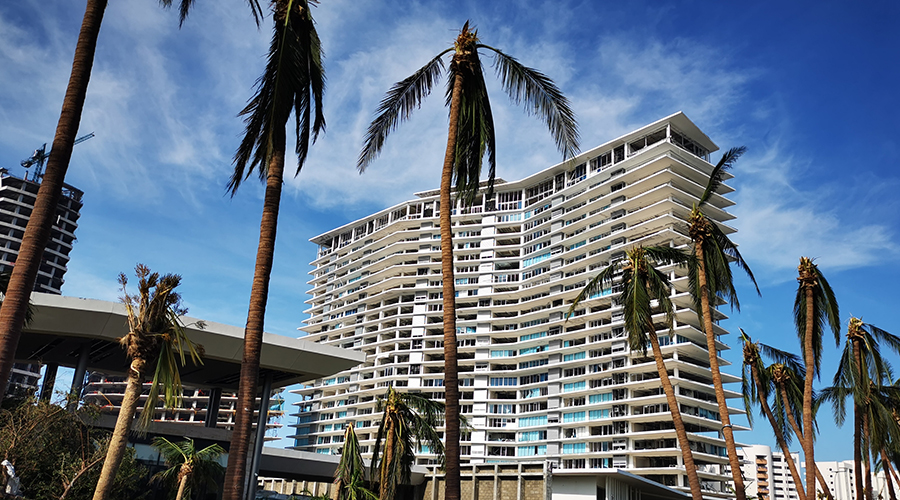Disaster Response Planning Tips from Preparedness and Remediation Pros
By Naomi Millán, Senior Editor
OTHER PARTS OF THIS ARTICLEPt. 1: This Page
Disasters fall into two camps, says John Wheeler, assistant vice president, field engineering group manager, FM Global. There are the disasters that are going to happen, and there are the disasters that might happen. He calls them "when" and "if" events. "There are 'if' events, such as a fire. 'If we ever had a fire,'" Wheeler says. "Natural hazard, such as flood and wind, those are a question of when. Preparation should keep that into consideration." Take note that he doesn't offer a "never" category for disasters.
Likewise, disaster response planning among facility managers falls into two categories, says William Begal, president of Begal Enterprises, disaster restoration specialists: Do you have a plan or do you not have a plan? "If you have a plan, if it's not a plan that is updated and practiced regularly, then it's worse than not having a plan," Begal says. "You have this sense of security, 'We have the red book, everything is ready to go, in the event that something happens' — but then the phone numbers are wrong or the vendor is not there or the guy that had the key to the water shut off room isn't where he is supposed to be or he's on vacation."
But you know that already, you're saying to yourself. Clearly, it is the job of the facility manager to plan for the likely and unlikely emergencies that will impact the facility, and it makes all the sense in the world to have the plan thoroughly updated and meticulously well-rehearsed. You also know you should floss your teeth every night, but we don't always do what we know we ought.
Begal and Wheeler deal with disasters every day — how to avoid them, prepare for them, and ultimately recover from them. From their experience with countless emergencies across facility types and geographic location, they have amassed a greatest hits list of dos and don'ts when it comes to smart disaster response planning and disaster remediation. Here is some of what they'd like all facility managers to know.
The first thing Begal would want FMs to do is to embrace that the worst could happen. Too often, he says, people will prepare for the smaller emergencies but they balk at preparing for something catastrophic. "I have had companies use us to be better prepared, walk us through their facilities, allow us to make recommendations to them and then they make some of the adjustments, but then they drop it because they don't think that it's going to happen to them," Begal says. "The more you're willing to look at the damage that will occur, the better prepared you'll be for what might occur on the big end. Yes, you don't hope that a tornado is going to destroy the building, but it might happen, if you're in the part of the world where those things occur."
Here are some of the other factors to consider.
Plan for the Unique Challenges of Your Location. Consider the characteristics of the hazards your facility might face. In regards to flooding, for example, what kind of water will it be? "One thing we've found, if there's an issue of flooding, it's important to consider the kind of water with which you'll be flooded," says Wheeler. "If it's in a coastal area, it's normally going to be salt water, which is easily ten times more destructive than fresh water."
Plan for No Power. Wheeler says facility managers should plan to loose all utility power. Therefore, do they have enough fuel for the generators, and can the generators run the HVAC? In a warm climate, after a hurricane, if you can't run the HVAC, mold and mildew will set in within a couple of days, he says. He tells clients to plant that if they have one foot of water in a high-end hotel, everything on the first floor is ruined, for example. If the building has an atrium, the damage will go higher.
Even if the utility power doesn't go down, it's best to shut it off in advance of the storm, he says. "There's a big difference if you loose power or [the storm] knocks the lines out but they're not energized," Wheeler says. "If they are energized, you go from something that can be cleaned and dried to something that has to be replaced entirely. It all goes back to preparation."
Verify the Supplies. Running drills and maintaining up-to-date contacts are essential to disaster response planning. But a step that might get overlooked is verifying the supplies you are planning on using to respond to the emergency are in place and in adequate condition. Wheeler cautions that materials can walk away, either through theft or as they become cherry-picked for projects, such as a stack of plywood intended for hurricane preparation slipping away sheet by sheet for this little thing and that. He remembered one client in Miami Beach had purchased nice metal flood barriers and they had them stored in an adjacent parking garage. When Wheeler's team asked the client to verify the location and condition of the items, they found the barriers had been stolen, likely sold for scrap. It had been two years since they had last been checked on. Materials can also deteriorate over time. Wheeler recounts another client who had planned ahead by buying enough plywood to handle their first floor doors and windows. The plywood was in a secure location, but when the client went to verify the count for Wheeler's team, they found the wood was infested with carpenter ants.
Know Who Will Stay. Facility managers often ask their departments to poll their employees to see who would stay in the event of a natural catastrophe, but Wheeler cautions to be wary of the number that comes back. It's one thing for someone to say they'll stay when the sky is blue, but quite another for them to stay when a storm is raging and their own house is under threat. " We always encourage them to take that number and halve it," Wheeler says. "Things happen. People have families, they have their homes to look after and our experience is you'll be doing very well if you get half of who said will stay." That said, facility managers will need to plan for training those who will be staying, and provide adequate food, supplies, first aid, and sleeping quarters for the duration of the emergency, he says.
Know Who Will Show Up. In addition to knowing who among the internal staff can be counted on during a disaster is ensuring external service providers are contractually bound to show up to the facility and render service in a timely fashion and at a fair price. "When it gets really busy, when there's something big like a hurricane or a big ice storm, all the vendors are really busy," says Begal. "Going to the phonebook at that time isn't going to help."
Having pre-service agreements in place, and updated on a yearly basis, with key vendors is crucial. "All the paper work is done, certificates of insurance are done, so that stuff doesn't have to be handled in the moment, if the proverbial happens," Begal says. Having emergency response times written into contracts ensures your facility is at the top of the to-do list.
Another factor to have in place is someone authorized to call the shots on purchase decisions or action items. Begal says often at a site, nobody wants to take responsibility for signing a work authorization, which bogs down the remediation process.
If facility managers are running into trouble getting authorization to adequately prepare their facilities for emergencies, Wheeler says they should consider taking the decision maker in question for a little tour. "Sometimes we're talking to a CFO and they're just politely nodding their heads," he says. "But if we take them on a walk and communicate what bothers us, it's going to bother them too. And they'll take action."
Email comments and questions to naomi.millan@tradepress.com.
Related Topics:











